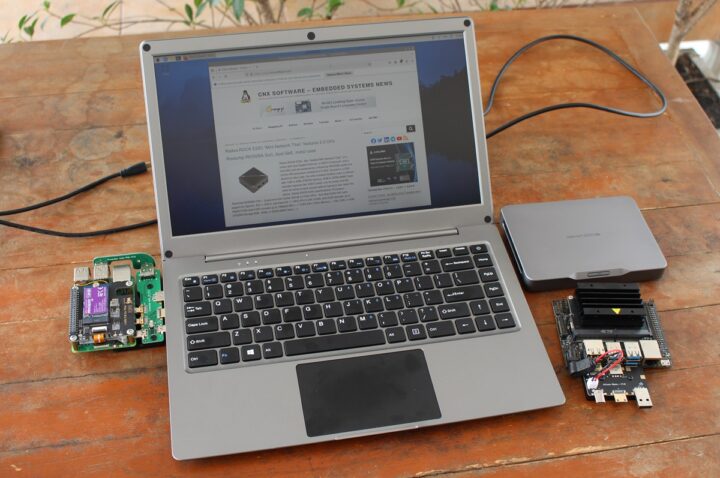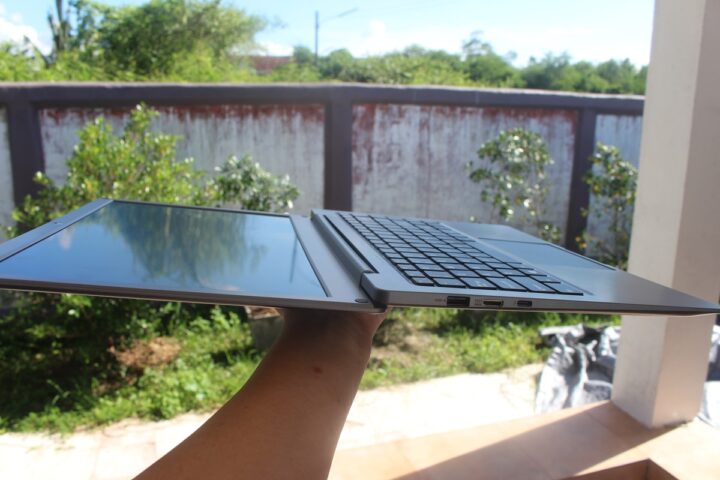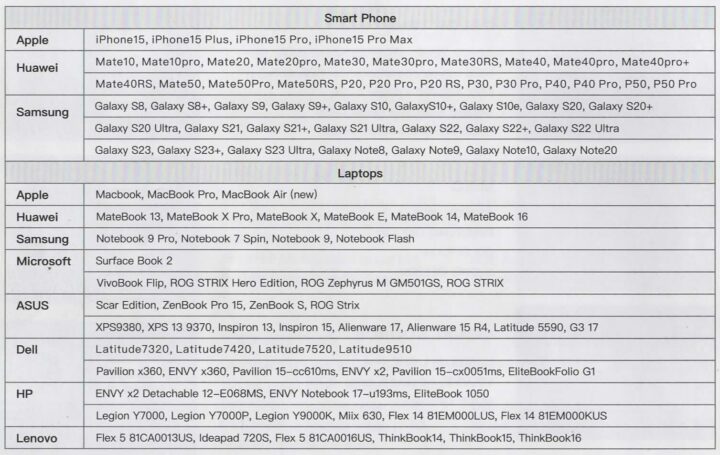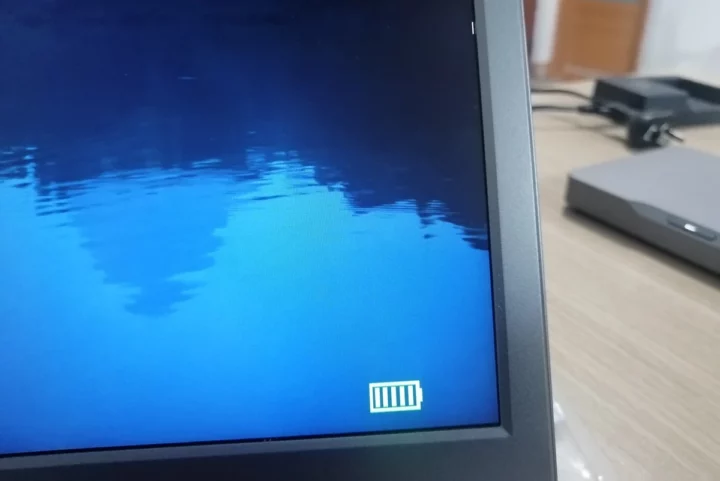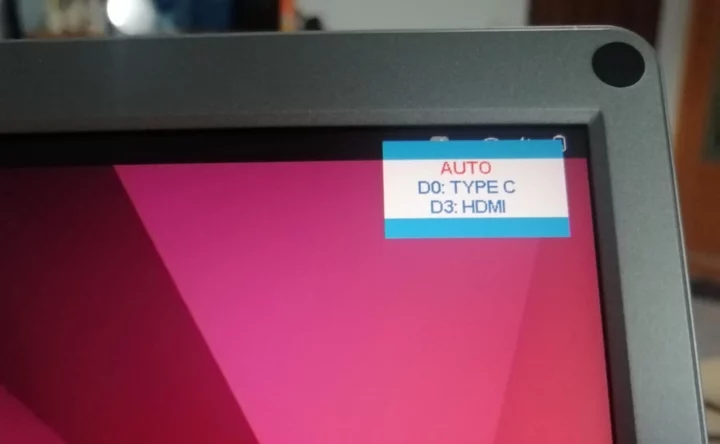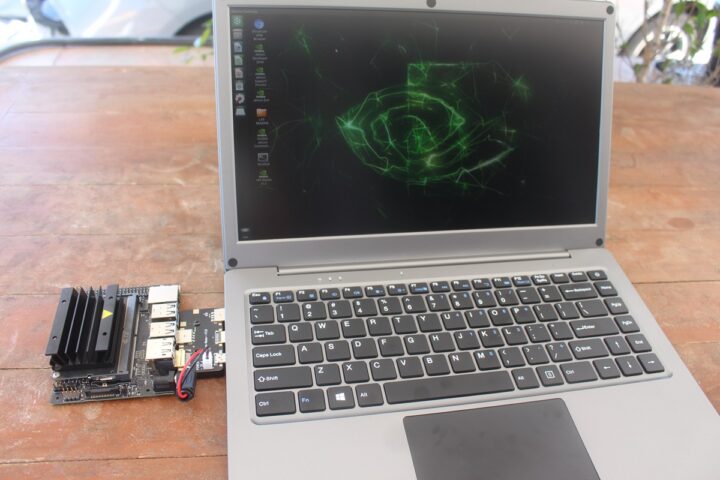Elecrow CrowView Note is a laptop shell with a 14-inch Full HD display, an 84-key QWERTY keyboard with a touchpad, built-in speakers and microphone, and a 5,000 mAh battery that’s specially designed for the Raspberry Pi 5 and the Jetson Nano Developer Kit thanks to adapters. However, it can be used with any machine with either a full-featured USB-C port or spare USB and HDMI ports. So it works with any Raspberry Pi model, Windows, Mac OS, or Linux computers, Android smartphones, PS4/PS5 game consoles, and more.
This type of laptop shell has been around for years with the first one being the Laptop shell for the Motorola Atrix 4G smartphone introduced in 2011, and more recently Nexdock launched a range of laptop shells such as the Neckdock XL 15.6-inch touchscreen display and wireless charging. The CrowView Note differentiates itself with its low price and direct compatibility with the Raspberry Pi 5 and Jetson Nano without any cabling required. The company sent us a sample of CrowView Note for review, and we’ve tested it with the Khadas Mind Premium mini PC running Windows 11 and Ubuntu 22.04, as well as a Raspberry Pi 5 and a Jetson Nano Developer Kit.
CrowView Note specifications
- Display size – 14-inch
- Type – IPS Panel
- Resolution – 1920 x 1080 (FHD)
- Brightness – 300cd/m
- Refresh rate– 60Hz
- Color Gamut – 100% sRGB
- Contrast ratio – 1000:1
- Aspect ratio – 16:9
- Audio
- 8Ω2W stereo speaker
- 3.5 mm audio jack
- Interfaces
- 1x USB 3.0 Type-C port (full-feature)
- 2x USB Type-A ports
- 2x Mini HDMI ports
- Power Supply
- Input – 12V/4A via DC jack
- Output
- 5V/5A via USB Type-C power port
- 5V/3A via full-featured USB-Type-C port
- Battery – 7.4V 5,000mAh
- Dimensions – 334 x 223 x 20 mm
- Weight – 1.2 kg (measured: 1,149 grams)
Unboxing
We received the device in the retail box shown below.
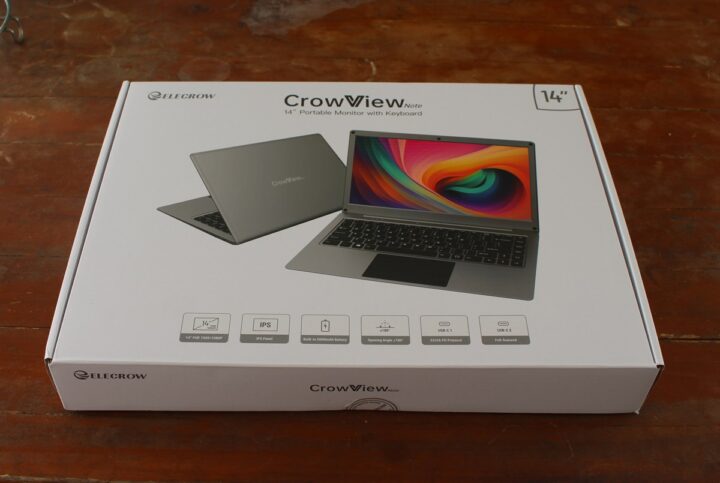
Some basic specifications can be found on the back side of the box and the company also highlights compatibility with Raspberry Pi SBCs, Jetson Nano Developer Kit, smartphones, PC, game consoles, and so on.
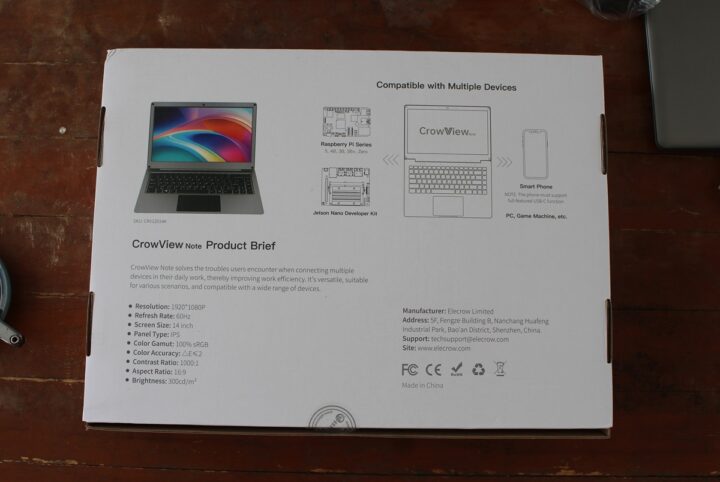
The package includes the CrowView Note laptop shell, a user manual in English, a 12V/4A power adapter, adapter boards Bridge Board A (Crowview note PI V1.0) and B (Crowview note-Pi5-V1.0) to connect a Raspberry Pi 5, and the Bridge Board (Jetson-Nano–V1.0) to connect a Jetson Nano Developer kit. No cables were included so for other devices, you’ll need your own USB-C cable or USB-A and (micro) HDMI cables.
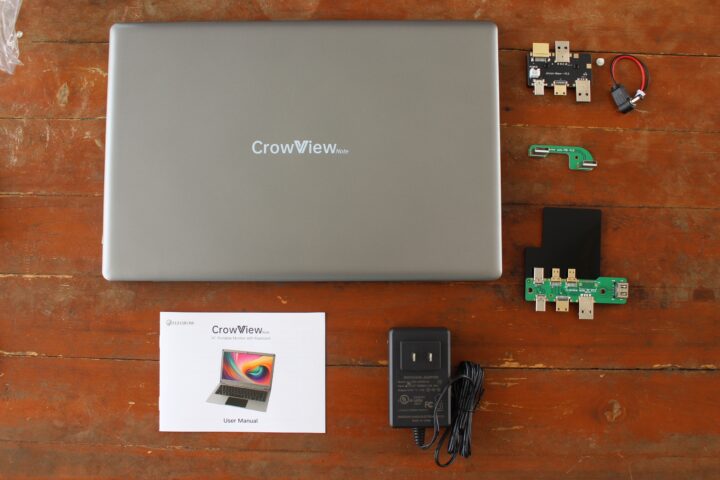
On the right side of the CrowView Note, we’ll find a full-featured USB Type-C port with 5V/3A output, a 3.5mm headphone jack, a USB 2.0 Type-A port, a 3.5mm DC jack for 12V DC power input, and charging LED.
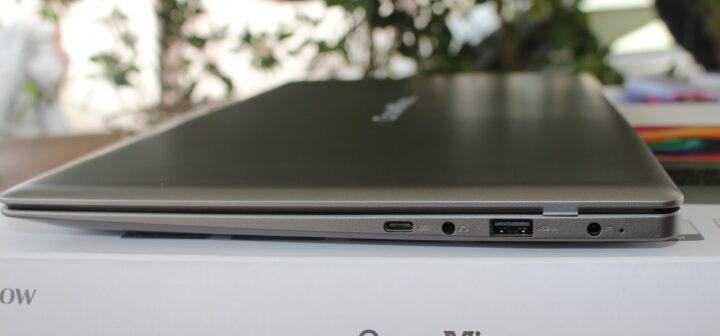
On the other side, we have another USB 2.0 Type-A port, a mini HDMI video output, and a USB Type-C port for 5V/5A power output.
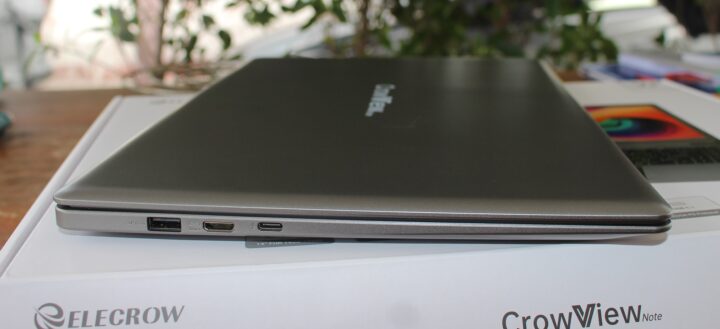
The laptop shell is only 20mm thick and relatively lightweight at 1.2 kg. The CrowView Note also features a built-in 5,000mAh battery that not only supplies power to the laptop shell itself but can also power devices connected to it making it easy to carry around.
The display also has a 180-degree hinge that allows it to be completely flat.
We can find three status LEDs on top of the keyboard: the power LED, CapsLock LED, and Num Lock LED. The hole on the right side of the first rectangle is for the built-in microphone. We also highlighted the power button on the top right since it’s used to power the laptop shell and the Raspberry Pi 5 and Jetson Nano board attached to it.

The two speakers can be found underneath the laptop shell.
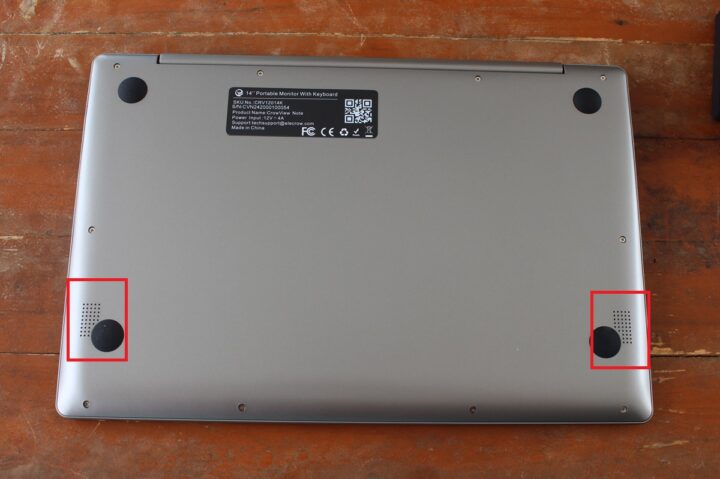
The company has designed adapter boards for the Raspberry Pi 5 SBC and Jetson Nano Developer Kit that eliminate the need for cables and make the laptop shell more portable even with a Raspberry Pi attached to it.
The Bridge Board A is an adapter board with two micro HDMI ports and a USB Type-C port that connect to the Raspberry Pi 5 and a USB Type-C port, a mini HDMI port, and a USB Type-A port that connect to the Crowview Note.
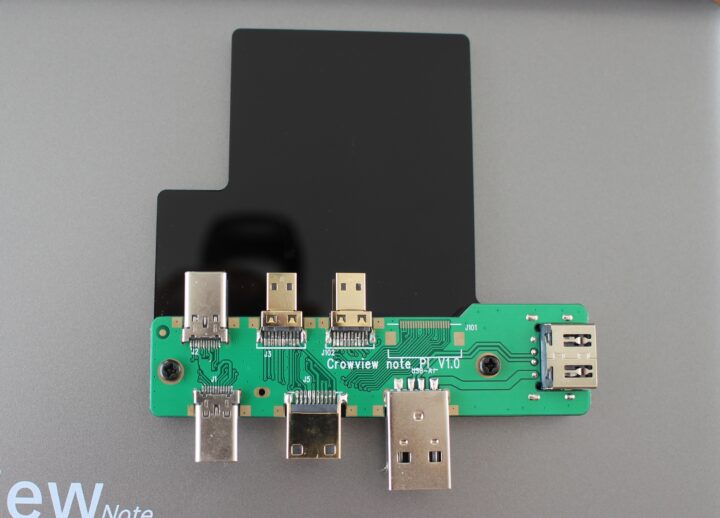
There’s also an additional USB-A port on the side that is used by the Bridge Board B board shown below with two USB Type-A ports to route the USB signals to the Raspberry Pi 5 to control the keyboard, touchpad, and microphone.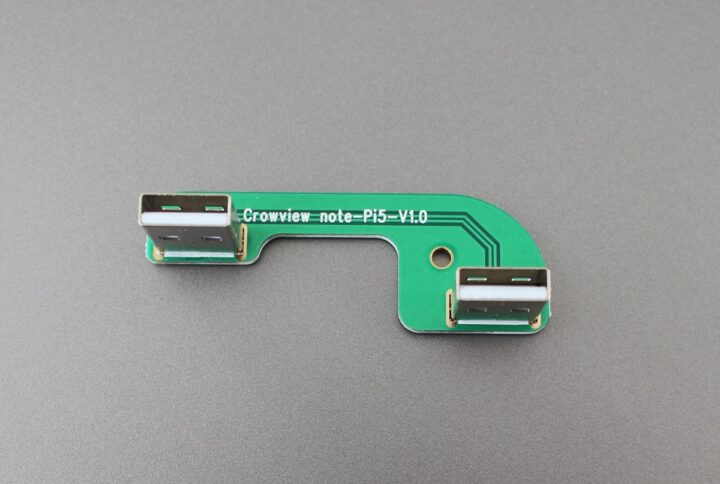
The Bridge Board for the Jetson Nano Developer kit comes with HDMI and USB Type-A ports connected to the developer kit, a USB Type-C port, a mini HDMI port, and a USB Type-A port connected to the laptop shell. There’s also a 2-pin connector with a “Patch Cord” used to power the board as well as two white PCB columns to raise the Jetson Nano carrier board.
Testing the CrowView Note with Windows 11 and Ubuntu 22.04
We’ll first test the CrowView Note with the Khadas Mind mini PC running Windows 11. Since the mini PC comes with a full-featured USB-C port we only need to connect a USB-C cable to the CrowView’s USB-C port. Since the Khadas Mind consumes more than the 15 Watts delivered by the USB-C port, we’ll also need to connect the power supply for the mini PC.
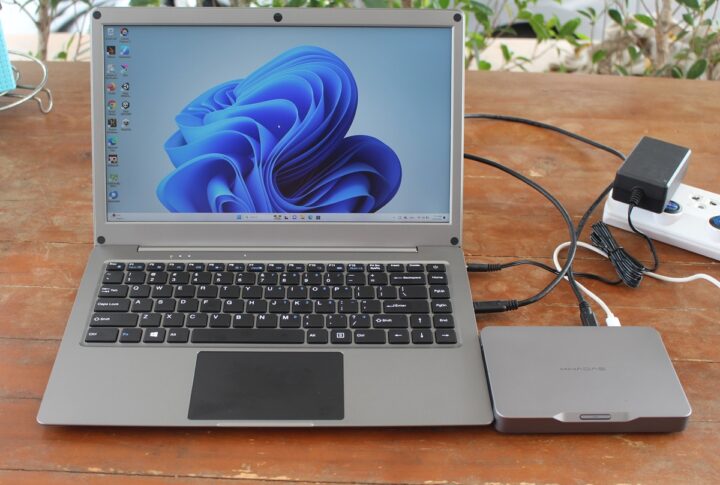
We can check the resolution and framerate in Windows Settings which reports an RTK FHD display with 1920×1080 resolution and a 60 Hz framerate.
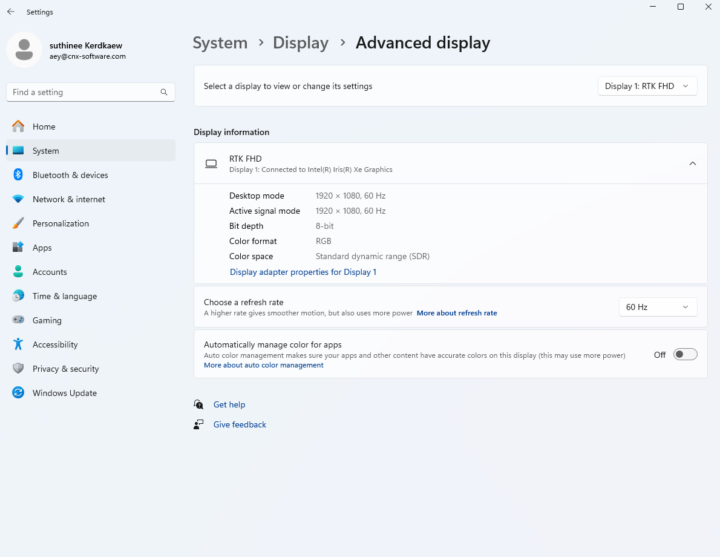
The keyboard and touchpad worked fine, and we also tested the speakers and microphone through an audio Skype call, as well as the 3.5mm audio jack with headphones. The design of the CrowView Note makes it look like there’s a webcam too, but sadly there’s an any…
We restarted the Khadas Mind mini PC to boot in Ubuntu 22.04 and everything works just as well as in Windows 11.
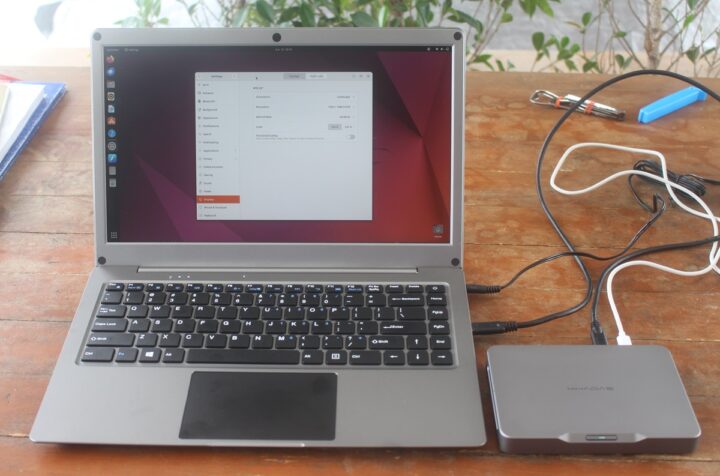
We don’t own any smartphone that can output video through USB-C, but the user manual contains an inexhaustive list of smartphones and laptops compatible with the USB Type-C (Full-feature) port.
Making a Raspberry Pi 5 laptop with the CrowView Note
When Elecrow first contacted us they told us they had a new Raspberry Pi 5 laptop, and we were expecting something like the CrowPi L laptop with a Raspberry Pi 4 embedded into the design. The CrowView Note can still be used as a Raspberry Pi 5 laptop, but in a more flexible albeit not quite as portable way (you may not want to throw it in a bag). We can just connect the Raspberry Pi 5 to the laptop shell through the two bridge boards to make the Pi 5 laptop. No cables needed.
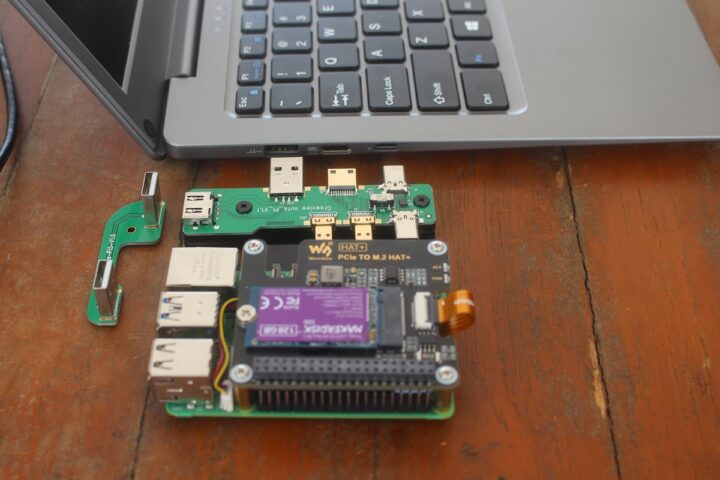
First, connect the Bridge Board A to the Raspberry Pi 5, then the Bridge Board B adapter board with 2 USB Type-A ports to the Raspberry Pi 5 and the Bridge Board A, and insert the assembled kits into the CrowView Note portable monitor.

Now make sure the on/off switch on the Bridge Board A board is on, and press the power button on the keyboard to boot the system.
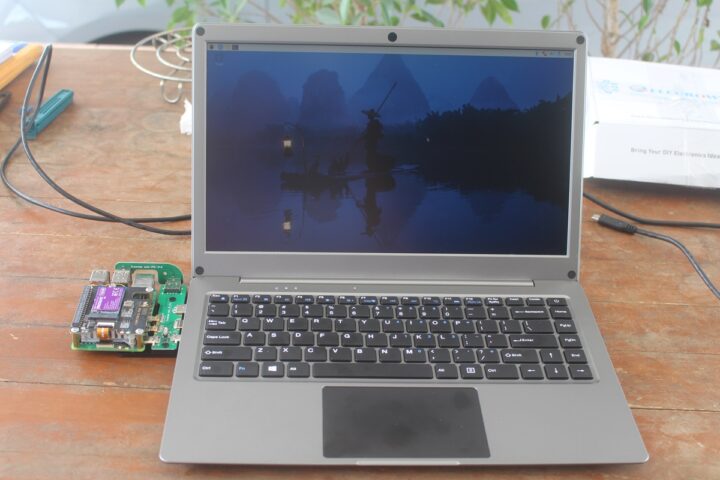
The laptop shell can work with the Raspberry Pi 5 only using its battery as we can see above. Note the first time, this did not work at all. After testing with cables, we found out the Bridge Board B was damaged as we did not get any power from the USB-C port. Elecrow promptly sent a replacement adapter, and everything worked after that. However note that the Raspberry Pi OS does not report the battery level, while Windows 11 and Ubuntu 22.04 do.
[Update: As noted in comments, it’s possible to use the F11 key to monitor the battery level with the OSD.
It’s also possible to connect a Raspberry Pi 5 on the left and a mini PC on the right and switch between two sources with the F1 key.

While on the battery subject, we also tested the battery life after a full charge (checked in Windows) while running stress utility on all four cores and the battery lasted 40 minutes. That’s almost the worst case (“almost” because we did not stress the GPU), and you can expect around 1h30 for a typical use case such as browsing the web or watching YouTube videos, so it may or may not be enough to watch a full movie for instance.
Testing the CrowView Note with NVIDIA Jetson Nano Developer kit
We also dusted our 5-year-old NVIDIA Jetson Nano Developer kit to give it a try by connecting it to the laptop shell using the provided Bridge Board adapter board that connected to the HDMI port and one of the USB Type-A ports of the board.
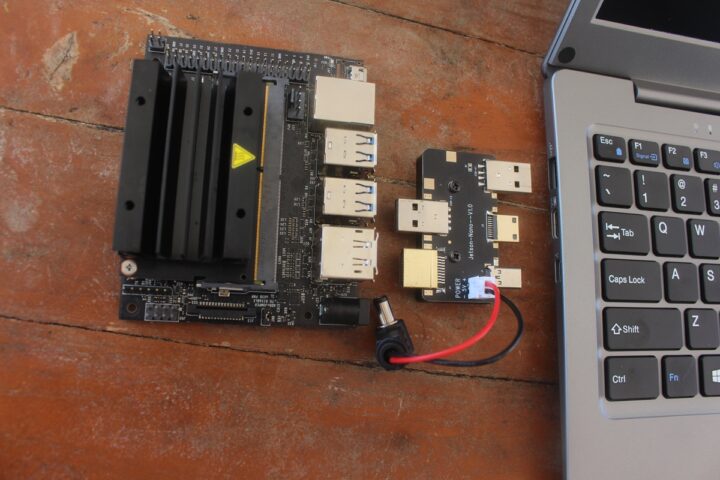
Power is handled by a “patch cord” providing 5V through the DC jack on the board.
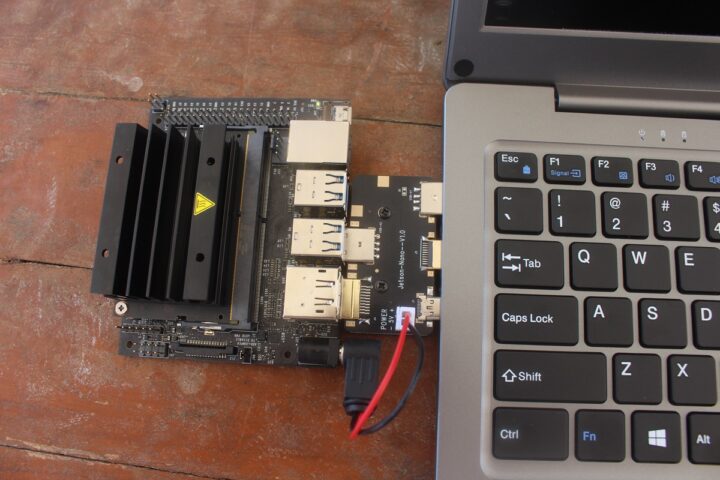
Our first Bridge Board would not mechanically fit into the ports on the laptop shell by probably less than one millimeter… So we also had to ask for a replacement for that one. Elecrow sent us an early prototype, so that must be why we had multiple issues with the adapters. Hopefully, they will have worked through those issues before sending it to actual customers. Anyway after we received the replacement, everything worked fine.
There’s no problem if you are using it on a desk connected to the 12V/4A power adapter. It also works on battery so the laptop can be carried around, but I’m less confident about the durability of the solution simply because the Jetson Nano Developer Kit is quite heavier than the Raspberry Pi 5. We haven’t tested battery life, but I’d expect it to be even shorter than with the Raspberry Pi 5 especially when using the GPU, so the battery may better be seen as a UPS solution here…
Conclusion
Elecrow CrowView Note is a relatively lightweight 14-inch laptop shell with an 84-key keyboard, touchpad, microphone, speakers, and built-in battery. It is easy to use and portable, and can be used with any device with a USB-C port with DisplayPort Alt mode or HDMI and USB-A ports. It’s especially well suited to the Raspberry Pi 5 and NVIDIA Jetson Nano Developer Kit thanks to the provided adapters that remove the need for cables.
Overall we are satisfied with the product, but we wish some cables were included, and it would have been nice to have a webcam too. The display is better used indoors, as it may be a bit dim outdoors. Some people may have wished for touchscreen support, but maybe that will be implemented in a future model.
We’d like to thank Elecrow for sending us the CrowView Note laptop shell for review and the optional adapter boards for the Raspberry Pi 5 and Jetson Nano Developer Kit. Elecrow has launched the CrowView Note on Kickstarter with a fundraising goal of $9,981 that has already been easily surpassed. Rewards start at $129.9 for a CrowView Note with a 12V/4A power adapter. The adapter boards for the Raspberry Pi 5 / Jetson Nano are not included by default and cost $5 extra each. They can be added while going through the “pledging process” for a CrowView Note. Shipping is scheduled to start in November 2024.
CNXSoft: This review is a translation – with a few additional insights – of the original article on CNX Software Thailand by Suthinee Kerdkaew.

Jean-Luc started CNX Software in 2010 as a part-time endeavor, before quitting his job as a software engineering manager, and starting to write daily news, and reviews full time later in 2011.
Support CNX Software! Donate via cryptocurrencies, become a Patron on Patreon, or purchase goods on Amazon or Aliexpress


